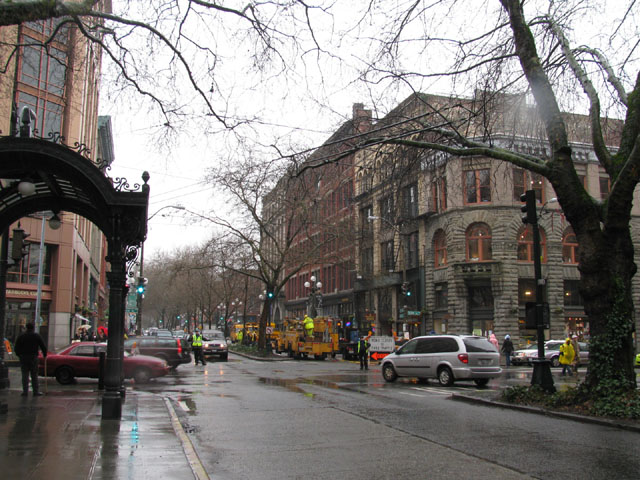A Microscope on Pioneer Square, Again
On Monday April 25, 2011, the Seattle City Council voted unanimously to approve the Livable South Downtown Ordinance, establishing significant zoning changes for Pioneer Square, Japantown, Chinatown/International District, Little Saigon and portions of SODO. This was the culmination of a multi-year planning effort by the City, led by the Department of Planning and Development (DPD). In addition to City staff and City Council members, particularly the Committee on the Built Environment (COBE), many others were part of the planning process including an advisory group, community stakeholders, residents, business owners, property owners, developers, neighborhood organizations, the Pioneer Square Preservation Board and International Special Review District Board. Moving forward, Seattle now has a workable model for a more livable and vibrant South Downtown that encompasses two local and national historic districts. The goals for more density, increased housing opportunities, and more economic vitality can hopefully be achieved by this plan and legislation, while respecting the historic built environment.
What grabbed attention in the last few months before the South Downtown legislation was passed was not the wonky land use planning process but the debate about building heights in Pioneer Square, Seattle’s first designated historic district and oldest commercial neighborhood. Early this year, preservationists advocated against an 11th hour request by a local developer and downtown business interests to increase heights in a large portion of the historic district to 180’. This request came in after public hearings were held about the Livable South Downtown Plan. This request also came in well after the Final Environmental Impact Statement was published in May 2008 and was not part of any environmental review or analysis. Preservationists became concerned about the future integrity of the district if out-of-scale development overwhelmed the character of the district’s core. Growth is happening around Pioneer Square and within the historic district at the south edge with more than 600 residential units being developed on the North Lot (the project, with a height limit of 240’, is breaking ground this summer.)
Because preservation advocates dared to speak out, once again, we were portrayed as obstructionists and not wanting “progress.” More accurately, preservationists (including some who are property owners in Pioneer Square—Historic Seattle owns the Cadillac Hotel) care greatly about retaining the character and historic context of the neighborhood while recognizing that the district needs to evolve and thrive. The two goals are not mutually exclusive. Thoughtful development, urban density and preservation can work together to succeed, not against one other. This was the message that preservation advocates consistently brought to City Council members through public testimony at recent Committee on the Built Environment meetings and through other meetings. Bottom line, preservationists support the height increases—we are not against height or density. Maintaining historic character and context need to be balanced with growth and change.
DPD recommended new height limit increases that would be compatible with the character of the Pioneer Square Historic District. The Pioneer Square Preservation Board supported DPD’s recommendations. The proposed new height limits were not arbitrary—they were grounded on analysis through the environmental review process. Under the new plan, Pioneer Square will have a base height limit of 100’ throughout the historic district. This is different from the confusing variable height limits that the new legislation replaces. Through incentive zoning, height limits throughout most of Pioneer Square will now extend to 120′ and 130′, even 150′ in a section just north of King Street Station. Then there’s the additional 15′ allowance for penthouse units on top of buildings. Most existing historic buildings in Pioneer Square are of modest height—three to six stories tall with Smith Tower being the exception. On average, these new height limits constitute a 50% or more increase in height throughout Pioneer Square.
At the March 9, 2011 COBE meeting, members recommended a compromise height of 130’ and 140’ in certain areas of the historic district. But at its April 13, 2011 meeting, COBE members split 2 to 2 on the compromised height increase, with two members voting to support DPD’s recommendations of 120’. Since the vote tied, what moved forward to the full City Council was the recommendation that passed at the March 9 meeting. Full City Council vote for the South Downtown legislation was set for April 25. Coming down to the wire, an amendment to the legislation was introduced on April 22 by Councilmember Nick Licata to support DPD’s recommendations.
City Councilmembers understood the careful balance at play and that we all want the best for Pioneer Square, so our goals are the same. Through thoughtful consideration and openness to listening to all sides of the issue, City Council voted to pass Council Bill 117140 as amended. COBE chair Councilmember Sally Clark deftly guided this process once the Livable South Downtown documents (a hefty 400+ pages) were presented to her committee last year. At the April 25 meeting, members of the Council recognized all the hard work that went into the multi-year planning effort and acknowledged the many individuals and organizations involved.
Now it’s time to move forward.
For further reading, below are links to news and blog articles about the Pioneer Square height issue.
“Council should adopt height increases in Pioneer Square.” PubliCola, April 18, 2011.
“Don’t cave to pressure on extra height in Pioneer Square.” PubliCola, April 19, 2011.
“City allows taller buildings for south-downtown areas.” Seattle Times, April 25, 2011.
“Marrying new and old in historic districts.” Crosscut, April 26, 2011.
Here’s a compilation of articles on seattlepi.com.
